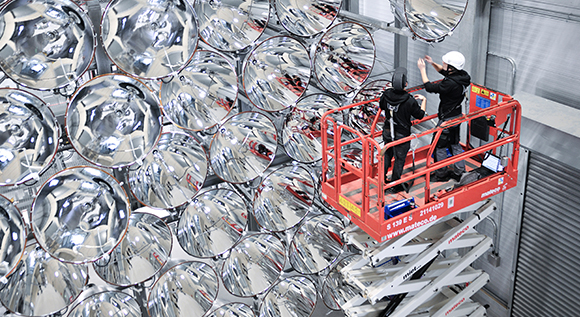Jülich is home to the world’s largest artificial sun
Sunlight at the touch of a button: the world’s largest artificial sun is to help researchers at the German Aerospace Center (DLR) produce solar fuels. The project receives funding from the Federal Ministry for Economic Affairs and Energy.
 © German Aerospace Center (DLR)
© German Aerospace Center (DLR)
Researchers at the The German Aerospace Center (DLR) are looking into how the power of the sun can be used: this March, the world’s largest artificial sun was ‘switched on’ in the North Rhine Westphalian town of Jülich – a project which has been provided with funding by the Federal Ministry for Economic Affairs and Energy. The Synlight lab system which consists of a large number of powerful spotlights, can create about 10,000 times the intensity of the solar radiation at the Earth’s surface. It is to help scientists identify new production processes for solar fuels such as hydrogen. These will make it possible, for example, to use your car without producing any harmful carbon emissions.
Temperatures at the target point of the lamps can reach up to 3000 degrees Celsius
The artificial sun’s 149 Xenon short-arc lamps can be activated individually or as a group with just one click of the mouse. Temperatures at the target point of the lamps can reach up to 3000 degrees Celsius. The researchers use these extreme temperatures to split water into hydrogen and oxygen. Scientists have succeeded in splitting water into its component parts in a lab before – however, they used only around 20 kilowatts. Synlight can generate around 350 kilowatts, which means that it has around ten times the power of traditional lab systems. The powerful spotlights used at the DLR work reliably and are not dependent on weather conditions, so the researchers do not have to worry about cloudy or rainy days.
The workshop, which has been built specifically for the Synlight project in Jülich, houses a 15-meter steel structure on which the lamps are arranged in a parabolic pattern. All of the spotlights can be adjusted in a flexible manner so that – depending on the test assembly – the light is pointed either at one spot or at a larger surface. The main goal of the research project is to find new ways to produce solar fuels. But the intense solar radiation can also be used for a high-speed simulation of how materials age. The Federal Ministry for Economic Affairs and Energy is providing 1.1 billion euros in funding for the Synlight project.
An overview of the Federal Ministry’s programmes that serve to fund energy research has recently been published in the 2017 Federal report on energy research (in German only). For more information, please go to direkt finds.

